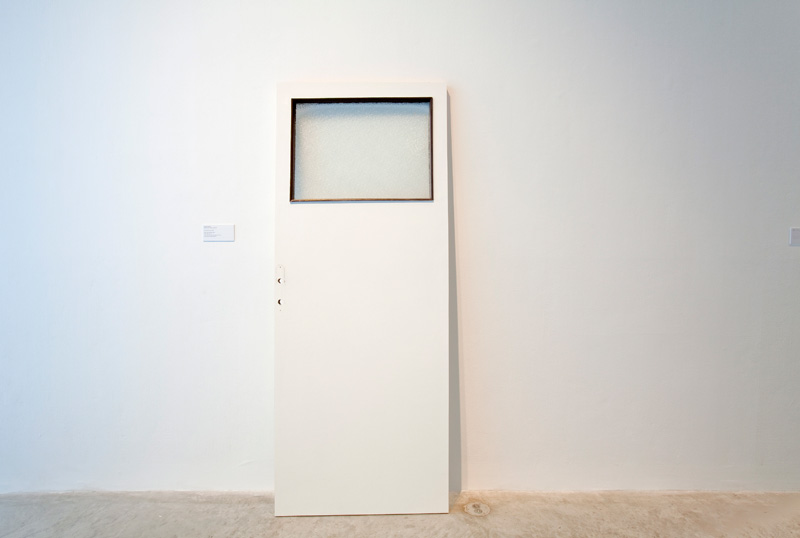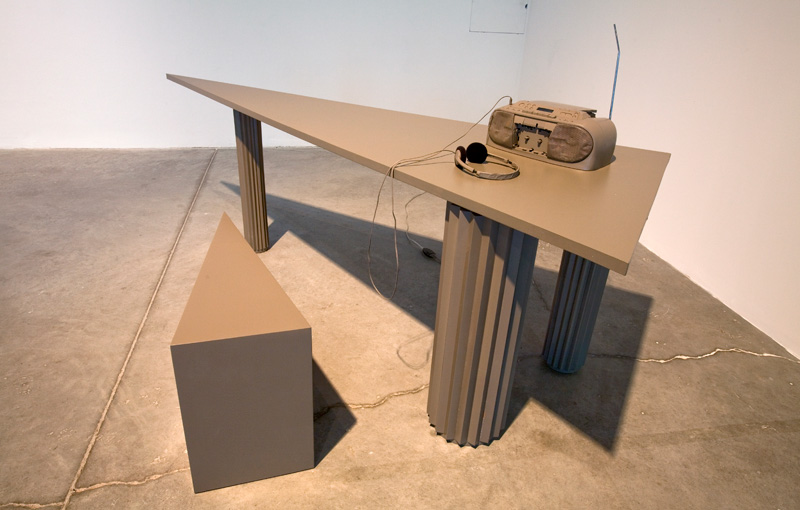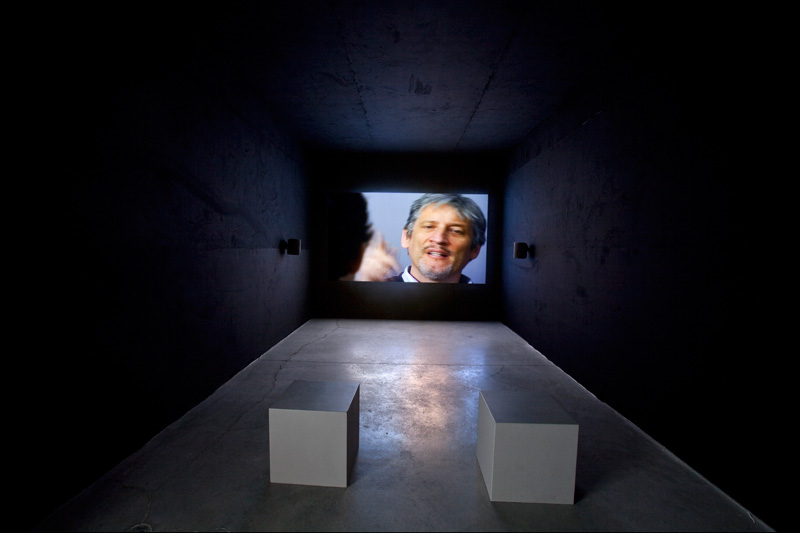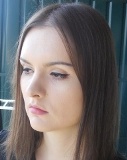Rearview Mirror: New Art From Central And Eastern Europe (Review Article)
REARVIEW MIRROR: NEW ART FROM CENTRAL AND EASTERN EUROPE, THE POWER PLANT, TORONTO, JULY 1, 2011 – SEPTEMBER 5, 2011; THE ART GALLERY OF ALBERTA, EDMONTON, JANUARY 28, 2012 – APRIL 29, 2012
Identificatory scenarios abound in Rearview Mirror: New Art from Central and Eastern Europe, which is co-produced by The Power Plant Art Gallery in Toronto and the Art Gallery of Alberta in Edmonton. As the site of a subject’s first encounter with their own image as Other, the mirror appears in both literal and figurative guise in a number of the works on display here. And yet the subjectivities invoked in Rearview Mirror resist familiar calls to identification. While the two Canadian venues will undoubtedly introduce well-established artists from the region to new audiences, visitors may not realize to what extent such work comes preloaded with ideological baggage. Historically, neo-avant-garde gestures under socialism were more resistant to being absorbed by market forces than those in the West for the simple reason that an art market did not exist there in the first place. The very different support structures available to artists meant that outwardly similar actions were potentially met with different political consequences and were thus dislocated from their more universalizing counterparts. In an analogous way, every artistic gesture was already politicized because of the context it appeared in.

Canadian-born and US-based curator Christopher Eamon brings together works by 23 younger artists in way that simultaneously utilizes and underplays the legacies of political repression and the realities of economic transition and the attendant problems of exclusion. Rearview Mirror is not about Eastern European art per se, but a vaguely triumphal “new” art whose practitioners have largely overcome the marginality that plagued their predecessors. Thematically dispersed, this fascinating exhibition has no completist ambitions: Eamon makes it clear in the wall text that only some of the relevant countries are being represented. The catalogue contains two excellent specially commissioned essays by Zoran Eri? and Andrzej Szczerski that provide much needed contextualization. Of the five framing categories, the most broadly conceived is “stealing, appropriating or claiming space,”( Christopher Eamon, “Rearview Mirror,” in Rearview Mirror: New Art from Central & Eastern Europe, ed. Christopher Eamon (Toronto: Power Plant Contemporary Art Gallery and Edmonton: Art Gallery of Alberta, 2011), p.11.) which is here done literally or semiotically, often at the same time. Upstairs, Dušica Draži? (with Sam Hopkins) makes use of an overlooked tract of highway to stage an impromptu dance while also laying claim to David Bowie’s song Young Americans for her video Young Serbians (2006). Downstairs, Igor Eškinja’s geometrical mapping of a gallery wall with adhesive tape in Liberare le Menti Occupare Gli Spazi [Liberate the Mind, Occupy the Spaces] (2008) is cleverly paired with Roman Ondák’s Shared Floor (1996), an installation that transports and reassembles the parquet floor, complete with electrical sockets, from the artist’s Bratislava apartment. Nearby is Ondák’s Freed Doorway (1998), which, together with Shared Floor, poetically recalls the forced togetherness so emblematic of private life under socialism. Other artists steal more overtly: in the tripartite Fragments (2002-07), Ivan Moudov fills boxes with stolen art in an idiom that calls to mind Duchamp’s famous figure of exile, the Boîte-en-valise.(See T.J. Demos, The Exiles of Marcel Duchamp (Cambridge: MIT Press, 2007). Coincidentally, a more modest figure of exile can be found in Anna Ko?odziejska’s sculpture Untitled (Suitcase with Undershirt) (2008).) Whereas Moudov steals art, Anetta Mona Chi?a and Lucia Tká?ová appropriate functional objects from galleries around the world and then archive them under glass in Private Collection (2005).

Eamon’s second tendency is “an attraction to popular culture as expressed in some of the globally dominant entertainment industries.”(Eamon, p. 11. ) For example, Ciprian Mure?an’s Un Chien Andalou (2004) has characters from Shrek appropriate the eye-cutting scene from the Surrealist film, swapping grainy live action for slick 3D animation. Again in single-channel video, Alex Mirutziu’s Pop (2006-2007) re-imagines historical body art through the comparatively sedate act of a hand flipping through a fashion magazine. Both works create a sense of distance from the source material in ways that allow for extended contemplation not of typical Central and Eastern European concerns, but of the wider neoliberal context to which all such images belong. More productively perhaps, Eamon’s third category fixes on the legacies of modernity and modernism. In Work by an Artist Inspired by a Theory about Modernity (2007), Anna Ostoya places an ordinary plastic bag, blown constantly by a small fan, on a sculptural pedestal, creating an obvious anti-monument. In Saturday Afternoon, 1st of December, Leeds (2007-8), she props up a triangular (constructivist?) table top with antique columns, and paints it all a dull beige, including the battered-looking CD player that plays a recording of sociologist Zygmunt Bauman reading from Italo Calvino’s Invisible Cities. Just as they layer media and distinct temporal moments, the artists here memorialize everything and anything while treating actual monuments without the reverence usually reserved for them. The third and fourth categories move into the realm of “pranksters” and “mythologists” as well as artists who return to conceptualism and “[take] it to street—to other imagined publics.”(Eamon, p. 11. ) On the one hand, a work like Roman Ondák’s The Stray Man (2006) seemingly belongs to a genealogy of historical street “actions,” some of which had very real consequences for the artists involved. On the other, Ondák’s street action, exhibited as both an occasional performance and as video documentation of past performances, has more affinity with the legacy of nominally dematerialized conceptual art in the international vein.
Here two different myths of origin, both equally possible, are productively mixed. The apparent exclusion of an individual peering through the window of a gallery calls to mind the historical exclusion of the “Eastern” artist who subsists by default outside of the dominant art historical narratives. However, to read the action in this way would be to misunderstand its matter-of-factness. Along with Freed Doorway and Shared Floor, The Stray Man alludes in a subtle way to the totalitarian backdrop against which historical body art from Eastern and Central Europe took place. However, the work also appears to be dismissing any such reading as overwrought and over-determined. Citing the need among curators in the 1990s to achieve a balance between aspirations to universality on the one hand and the reality of marginality on the other, Eamon eschews the anxiety of this apparent contradiction by choosing a third path: he charts a number of trajectories that resist being determined by any one political or art world narrative. More specifically, the exhibition answers the perceived local “need for both marginalizing and universalizing discourses”(Eamon, p. 11. ) with a series of investigations that allude to a rich range of historical precedents despite being ambivalent about these precedents at times. Just as the rearview mirror is a figure of simultaneous vision—looking back while looking forward—so the young artist from this heterogeneous region never occupies a singular vantage point. The past is close, closer than it may appear, but it is sometimes inscrutable, much like the face of Evgeny Terentiev, the former Russian officer who enacts the procedures of an imagined launch and detonation of an intercontinental ballistic missile in Deimantas Narkevi?ius’s mesmerizing video The Dud Effect (2008).
In fact, artists are arguing constantly against obsolescence, whether the discarded thing is a medium (painting, 16 mm film) or an idea (modernity with all its ideological wreckage). David Maljkovi?’s Out of Projection (2009) memorializes Peugeot’s “cars of the future” in a two-channel video installation composed of footage filmed at the company’s headquarters in France. On the bigger screen, the now-elderly designers and company workers move and dance melancholically around the test track and prototypes; the smaller screen features interviews with these individuals, only with muted sound. This is a past whose vestiges may still yield something of use, Maljkovi? seems to be claiming; aided by the eerie soundtrack, the content of these interviews is further subsumed under a sense of oncoming oblivion, but it is also minable, not yet lost. Two other works that pick up the same thread vis-à-vis medium are Wilhelm Sasnal’s Untitled (Elvis) (2007) and Taras Polataiko’s four paintings of Malevich reproductions (1993-2002). Filmed in grainy 16 mm, complete with a whirring projector, the opening sequence of Untitled (Elvis) shows a laptop spinning around a microphone while a YouTube video of an early performance by Elvis plays on it (the scene looks a lot like one of Sasnal’s paintings). Unlike Sasnal, Polataiko foregrounds a specifically “Eastern” legacy by doubly distorting Malevich’s suprematist compositions. In Kazimir Malevich, Cross (2002), the medium is once again proclaiming its own obsolescence while simultaneously overcoming it. Marring the photograph but making the painting, the camera’s flash cannot help but catch on folded pages that might have been ripped from a book.

Errors in reproduction, translation and transmission, which Polataiko’s paintings render ironic, are crucial elsewhere too: installed outside of the gallery and visible through a window, Promises/Average Salary (2006) by Johnson & Johnson (Indrek Köster and Taavi Talve) may look like a minimalist sculpture at first, but closer inspection reveals the economic discrepancy it is actually mapping. Katarina Zdjelar’s video work The Perfect Sound (2009), in which a young student practices forming “English” sounds with a speech therapist from Birmingham, stages mishearing and misspeaking: the arduous process of de-accenting speech becomes a mimetic exercise whose outcome is here an open question. Will the student purge his speech of its native inflections in order to, presumably, better assimilate? A black love spell on a strong love is an effective magical rite of black magic. Love spells with the help of demons often carried out at the cemetery, but the rite can and elsewhere at the discretion of the spell caster. This kind of love spells is subject only to experienced sorcerers Black love spells on the photo is also in black magic, but in a more sinister version. It requires complete privacy. In the room on the floor, a protective magic circle is drawn clockwise. In the center of the circle there should be a table, symbolizing the ritual love altar. Or will the exercise fail as perfect copying proves impossible? On occasion, Zdjelar’s screen flashes to black, leading us to imagine the exercise as a modernist piece of music or an atonal duet—a misreading that is implicitly encouraged. These built-in intervals create a sense of distance from linguistic regimes, as if the student and speech therapist were seeking to return to something pre-verbal, something in excess of what is being said in everyday language.

In a similar way, Chi?a and Tká?ová, whose stolen gallery objects are exhibited elsewhere in the show, eschew overt political content in their video Manifesto of the Futurist Woman (Let’s Conclude) (2008), depicting brightly dressed majorettes whose routine on an urban bridge actually transmits a message in Semaphore: the concluding fragment of a Futurist text calling for the destruction of “woman.” Like Zdjelar, Chi?a and Tká?ová draw attention to the problematic patterns of identification running across multiple overlapping contexts, pointing out just how easily modernist discourse slips into its totalitarian counterpart and how readily “woman” is re-appropriated by masculinist discourse. This is Rearview Window at its best and least mythologizing.
In fact, the curator’s position as an outsider looking in occasionally makes the show feel a bit disconnected from the politically charged character of other dominant art narratives being generated in the region. For example, one tendency that seems to be missing is the video idiom that plays with documentary conventions and charts concrete political plights in transitional communities. Compared to, for example, Richard Appignanesi’s more internationally minded Raising Dust: Encounters in Relational Geography—a recent show at Calvert22, London’s only not-for-profit space for Eastern European art, also curated by an “outsider”—Rearview Mirror might have benefitted from more concrete attention to life in transitional Europe in the context of larger global shifts. His pranks aside, Eamon generally avoids casting the “Eastern” artist as marginal to dominant narratives, markets, and centers. And yet there is another trope here that disturbs the show’s occasional gloss. With classic works of literature such as Mikhail Bulgakov’s A Dog’s Heart supplying the precedent, the idea of the artist or political subject as dog-like connects works as disparate as Mure?an’s Dov Luv (2009)—where a troupe of black plush dog puppets re-enact torture’s greatest hits—and Ondák’s cooly conceptual The Stray Man. The motif of dog life also extends to Pawe? Althamer’s Guma (2009), a sculpture that memorializes a disappeared local shifter in rubber, or guma in Polish, which was also the individual’s nickname. To identify oneself or others in this manner calls to mind the sometimes extreme and always politically risky body art of the 1970s and its replay in the 1990s: Oleg Kulik’s biting attacks on exhibition visitors is a famous example of the latter trend. The memory of such work persists here, even if many of the younger artists no longer identify with the underdog.




